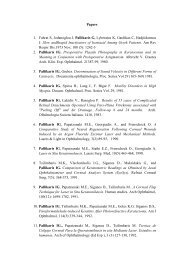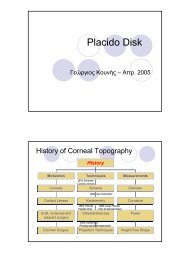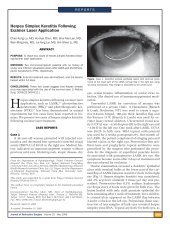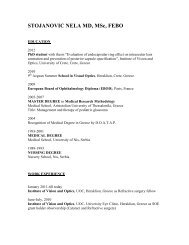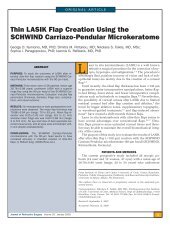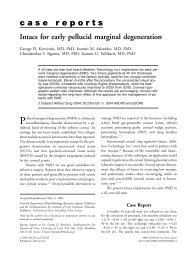Efficacy of 2 types of silicone hydrogel bandage contact lenses after ...
Efficacy of 2 types of silicone hydrogel bandage contact lenses after ...
Efficacy of 2 types of silicone hydrogel bandage contact lenses after ...
Create successful ePaper yourself
Turn your PDF publications into a flip-book with our unique Google optimized e-Paper software.
2106 SILICONE HYDROGEL BANDAGE CONTACT LENSES AFTER PRK<br />
Figure 3. Plot <strong>of</strong> the mean epithelial defect size on all postoperative<br />
days. The error bars represent G1 SD. Values at day 5 correspond to<br />
11 eyes and 12 eyes (lotrafilcon A and lotrafilcon B, respectively)<br />
(Day 0 Z day <strong>of</strong> surgery).<br />
LASIK or by promoting reepithelialization <strong>after</strong> PRK<br />
or LASEK. 5,9,10<br />
Contact <strong>lenses</strong> interact mechanically with the cornea<br />
and modify the physiologic processes <strong>of</strong> corneal tissue,<br />
reducing corneal function. The most frequent complications<br />
<strong>of</strong> <strong>contact</strong> lens wear are the direct result <strong>of</strong><br />
Figure 4. Subjective pain (top) and vision (bottom) on all postoperative<br />
days (Day 0 Z day <strong>of</strong> surgery).<br />
impaired oxygen supply to the cornea. Rigid gas--<br />
permeable and s<strong>of</strong>t <strong>contact</strong> lens materials with high<br />
oxygen permeability have driven the success <strong>of</strong> continuous<br />
wear because they have eliminated the hypoxic<br />
effects previously associated with extended-wear<br />
<strong>lenses</strong>. 17,18 Essential to this was the establishment <strong>of</strong><br />
corneal oxygen requirements and the development<br />
<strong>of</strong> materials and manufacturing techniques to meet<br />
those requirements. The introduction in the late<br />
1990s <strong>of</strong> <strong>silicone</strong> <strong>hydrogel</strong> <strong>contact</strong> <strong>lenses</strong> designed for<br />
continuous wear was beneficial to the field <strong>of</strong> refractive<br />
surgery. The high oxygen transmissibility <strong>of</strong> these<br />
<strong>lenses</strong> alleviates hypoxic-induced complications,<br />
enhancing wound healing and epithelial cell reproduction<br />
<strong>after</strong> refractive surgery.<br />
Photorefractive keratectomy, a well-established<br />
flapless refractive procedure, has been performed for<br />
more than 20 years. 1 However, significant drawbacks<br />
<strong>of</strong> PRK remain; that is, it causes greater postoperative<br />
pain and more delayed visual recovery than LASIK.<br />
The therapeutic value <strong>of</strong> the lotrafilcon A <strong>bandage</strong><br />
<strong>contact</strong> lens has been shown, 19 as has its efficacy in<br />
achieving faster corneal reepithelialization and in reducing<br />
discomfort <strong>after</strong> PRK. 10 Therefore, we evaluated<br />
whether another <strong>silicone</strong> <strong>hydrogel</strong> <strong>bandage</strong><br />
<strong>contact</strong> lens with different technical characteristics<br />
produced by the same manufacturer would have the<br />
same efficacy. Our hypothesis was that a <strong>bandage</strong> <strong>contact</strong><br />
lens <strong>of</strong> lotrafilcon B, which has FDA approval for 6<br />
days <strong>of</strong> continuous wear (versus 30 days for the lotrafilcon<br />
A lens), would be as efficacious as the lotrafilcon<br />
A lens in reepithelialization <strong>after</strong> PRK.<br />
Recently, Gil-Cazorla et al. 5 evaluated the efficacy <strong>of</strong><br />
2 <strong>types</strong> <strong>of</strong> <strong>silicone</strong> <strong>hydrogel</strong> <strong>contact</strong> <strong>lenses</strong> used as<br />
a <strong>bandage</strong> <strong>after</strong> LASEK. The 2 <strong>lenses</strong> differed significantly<br />
in oxygen transmissibility, water content, surface<br />
treatment, and initial modulus. The authors<br />
found no significant differences between the 2 <strong>lenses</strong><br />
in vision, corneal epithelial status, conjunctival and<br />
limbal hyperemia, or lens movement. However, the<br />
results are not directly comparable to those in our<br />
study because <strong>of</strong> the significant differences between<br />
LASEK and PRK.<br />
The present study, in which each patient wore both<br />
<strong>types</strong> <strong>of</strong> <strong>lenses</strong>, was a direct comparison between lotrafilcon<br />
A and lotrafilcon B lens <strong>after</strong> PRK. We controlled<br />
factors that could influence the epithelial healing process,<br />
such as the environment and physiologic healing<br />
response, and patients and examiners were masked to<br />
which type <strong>of</strong> lens was in which eye. Although, on average,<br />
eyes with a lotrafilcon A lens had slightly smaller<br />
areas <strong>of</strong> epithelial defect than eyes with a lotrafilcon<br />
B lens, there were no statistically significant differences<br />
between the 2 <strong>lenses</strong> at any postoperative examination.<br />
There was also no difference in the number <strong>of</strong><br />
J CATARACT REFRACT SURG - VOL 35, DECEMBER 2009


